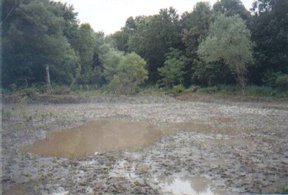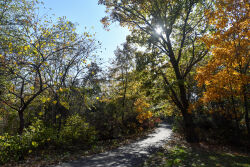Seton Falls Park
The Daily Plant : Tuesday, June 22, 2004
20 YEARS OF MANAGING NATURAL AREAS: RESTORING WETLAND LANDSCAPES

Parks & Recreation’s Natural Resources Group (NRG) is celebrating its 20th anniversary in 2004. Established in 1984, NRG works to protect, acquire and restore Parks & Recreations’ natural areas, including 51 Forever Wild sites and other non-developed areas totaling more than 11,000 acres.
On opposite ends of the north Bronx, near the Westchester border, lie two isolated and rare features once common in the landscape: freshwater wetlands. Two very different wetlands located in Seton Falls Park, in Eastchester, and at Alder Brook, in Riverdale, have received much-needed attention thanks to $1.1 million awarded to NRG under the Clean Water/Clean Air Bond Act. The projects were designed by NRG to enhance and restore critical functions that these sites perform, such as the provision of feeding and rearing habitats for aquatic organisms and birds, storm water detention, sediment retention, groundwater recharge and water quality improvement. Both reconstructed wetlands also offer unique oases for bird watchers and plant lovers, and beautiful scenic views from adjacent forest park trails.
During the winter of 2002, the reconstruction of the wetland at Seton Falls Park began with the removal of an acre of 10-foot high Phragmites, over 3,000 cubic yards of contaminated fill and the installation of a small weir to help control water levels, particularly for planting. Between June 2002 and August 2003, NRG joined with volunteers to plant over 13,000 wetland herbs and grasses, over 1,200 wetland shrubs and over 600 trees in the wetland floodplain. Now, instead of the impenetrable stand of wetland weeds that once dominated the wetland, a mosaic of varied native grasses, rushes and sedges inhabit the site. Some of the most successful native species planted are pickerelweed (Pontedaria cordata), three-square (Scirpus americanus), crinkled sedge (Carex critina), fox sedge (Carex vulpinoidea), and woolgrass (Scirpus cyerinus). The open wetland has attracted some long absent native birds as well, such as the glossy ibis and snowy egret.
At Alder Brook, the floodplain wetland rehabilitation in Riverdale Park was largely completed during the summer of 2003. Dumping of fill in the park, flashy stormwater runoff and high sediment loads have changed soil and channel conditions, creating an environment favorable to colonization by invasive species. Japanese (Polygonum cuspidatum) and hops (Humulus japonicus) had overtaken the floodplain to the exclusion of most other native floodplain plants. This spring, the knotweed and hops were removed and the main channel, which had been littered with construction debris, was reconstructed to minimize bank erosion at the toe of the steep adjacent hillslope. To combat the invasive species and contain sediment, a small detention basin was constructed at the mouth of the brook. Over 700 woody shrubs, and over 7,800 grasses and herbs – most chosen for their ability to tolerate damper conditions than knotweed – were planted in and around the floodplain.
As is typical for wetland reconstruction projects, it will be several years before the hydrology and vegetation reach some sort of equilibrium at Seton Falls and Alder Brook. In the meantime, NRG will continue to combat invasive species at these and other sites around the city.
Written by Marit Larson
QUOTATION FOR THE DAY
"He who is cruel to animals becomes hard also in his dealings with men. We
can judge the heart of a man by his treatment of animals."
Immanuel Kant
(1724-1804)
Check out your park's Vital Signs
Clean & Safe
Green & Resilient
Empowered & Engaged Users
Share your feedback or learn more about how this park is part of a
Vital Park System










